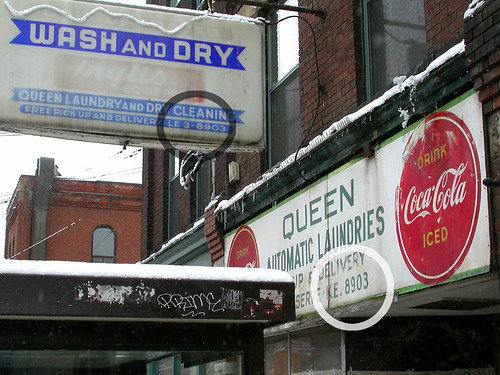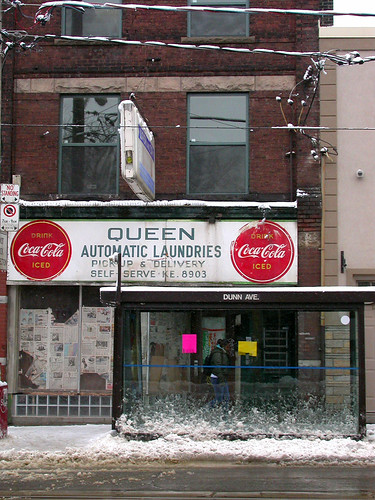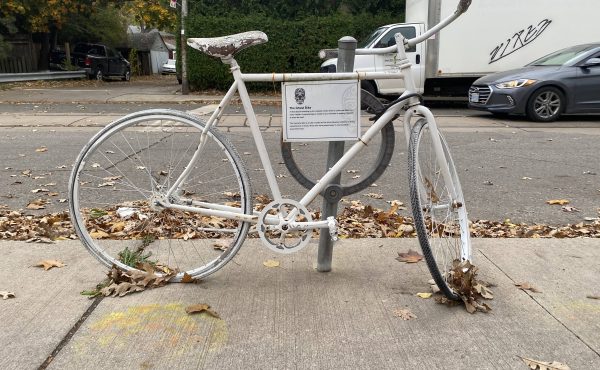
When I was growing up in the Toronto suburb of Willowdale, the community where “Downtown North York” is located, almost all of my friends had phone numbers that started with 22 (as in 226-2174, the home number of my youth, now in use by a real estate agency). My father explained to me, at the tender age of 10, that phone numbers used to contain letters. Willowdale was once known as the village of Baldwin, so the first two letters of anyone with a phone in our neighbourhood were BA, or numerically 22. This phone number practice was reinforced a little later in my life when I watched a number of Simpsons’ episodes in which the characters give out the family phone number (Homer’s Mr. Plow business was KL5-3226, the KL representing TV’s fake 55 prefix).
Last summer, I was walking along Queen Street in Parkdale with the Globe and Mail’s David LeBlanc, the Architourist columnist. He pointed to the store sign of Queen Automatic Laundries: it had one of those old phone numbers still on display (above photo). He noted that it was quite old since the phone number was only six digits (KE-8903) instead of the currently common seven-digit number. The Parkdale phone prefix back then was KE (for Kenwood), which is still in use today as a 53 prefix.
What was even more exciting to discover was that the store’s illuminated sign that hung out over the sidewalk also used the alpha-prefix, but with different letters and seven digits (LE3-8903 — the LE stands for Lennox). According to LeBlanc, this is the only place in the city in which two “historic” phone numbers co-exist on signage. As you see in the photo below, the laundry mat is closed, the windows covered by newspapers. As Parkdale’s commercial strips change over time, this storefront and sign will be most likely be replaced (though, this strip of Queen Street has numerous store vacancies).
Personally, I only know of one other storefront sign, somewhere on Roncesvalles, that still contains an alpha-prefix phone number. Do Spacing readers know of any other store signs that contain “historic” phone numbers?




31 comments
Really cool article. What other prefixes were used across the city?
And who can forget KL5-4796, the phone number for the Plow King (as sung by Linda Ronstadt).
There is still at least one in the Annex, although I cannot (of course) remember which store/sign specifically contains it. Near Curbside cycle shop.
According to this handy but very slow website (and another list I saw ages ago but can’t find now), LE stood for “Lennox”. I briefly tried giving out my phone number as “Lennox 3”-blahblahblah.
http://rcrowe.brinkster.net/tensearch.aspx
I don’t know of any others, but I do recall my mom telling me that growing up in Weston her phone number was often referred to as “CHerry”-1-8-0-6-7.
Lennox! I knew that, but totally forgot. Thanks.
A little off topic, but here’s another tidbit – when area codes were introduced in 1947, the numbers corresponded, more or less, to the city’s stature at the time.
The shortest possible code on a rotary phone (in terms of clicks) was 212, which went to New York. Other big cities like Chicago and LA took similar low codes (312, 213 respectively) with big industrial centres like Detroit (313) and St. Louis (314) close behind. Smaller cities like Montreal and Toronto received longer numbers that were comparable to Houston (713) or San Francisco (415). (Note that Montreal slightly outranked Toronto — 514 is one click less than 416).
Rural areas (and all of Canada outside Ontario and Quebec) got stuck with the dreaded “0” digit. BC’s 604 was 15 clicks longer than Manhattan’s 212. Almost as insulting as forcing all Canadian airports to start with a Y…
I wait for the queen car quite often there and have wondered what was up with the phone number but never really looked into it.
Thanks!
Not exactly an instance of a historic phone number, but the sign hanging over the garage on the west side of Ossington at Rolyat has a 416 number on one side, and a 212-555-xxxx number (NYC area code with the fake tv/movie exchange) on the other.
And here’s David Leblanc’s G&M article on the same topic from 2006:
http://www.theglobeandmail.com/servlet/story/RTGAM.20061116.archi17/REStory/RealEstate/
Growing up in the west end, the four exchanges Murray, Roger, Junction and Lyndhurst were combined into Roger – . Murray became Roger 2, Junction was Roger 9 and I’m not clear about the other two.
Everybody’s prefix clearly let one know where they lived in the city. Baldwin was Willowdale, Oxford was the east end near Kingston Rd. Melrose was Downsview. Empire was downtown and Hudson, Randall and Russell were north-end (above St. Clair).
Sadly, letter combination were running out and it was necessary to go to all number calling in the early sixties.
Thanks for the info, I always wondered how the old phone system worked. Especially after listening to songs like “Beechwood 4-5789” and “Pennsylvania 6-5000”
There are a few around but I’m blanking. The one that popped into my head first was the old “printing printing” storefront  now destroyed by “progress.”
Thank heaven for Kevin Steele:
http://www.flickr.com/photos/kevinsteele/89109811/
I may be wrong but the bar “Chino” in Parkdale has an old sign with a bike on it that *might* have an old letter-prefix number on it.
Ah, seconds later and Kevin solves the Chino question too:
http://www.flickr.com/photos/kevinsteele/150411237/
Not a letter prefix but a great old sign regardless. Kudos to businesses that move in but at least reference the heritage of the spaces they’re in. The “Clairemont Convenience” sign on Terroni is another example of this.
Brampton (the old part) has numbers starting with 45, and had the GLendale exchange. Bramalea (Chinguacousy Township) was 79, or SWift.
The Sea-Hi Chinese Restaurant on Bathurst south of Wilson still has a sign (a great neon one at that) with RU9-1258. The RUssell exchange.
http://ourwebhome.com/TENP/Historical.html
And a piece of telephone trivia I found while researching another book: the world’s smallest telephone company was the Methodist Episcopal Corporation of Kingston, Ontario. This company had exactly one subscriber: the Methodist church in Carmanville, Ontario. Sometime in the ’40s, the minister there got sick of having to drive home to Enterprise (a fair distance) to use the telephone. So, he had a simple switch built in the church, ran some poles and line out to the nearest Bell connection, and had a phone installed in the church. This odd little arrangement apparently continued until 1970 (!) when the Methodist Episcopal Corporation was bought by Bell. How’s that for a mega-merger?!
Ah yes, my first phone number in Canada; OXford 9 4605 (Beaches).
[they were much easier to remember (as long as you didn’t dial the ‘ford’ part!)]
B
In the west end we had, as noted, CHerry in Weston, BElmont in Islington and CLifford in Mimico/New Toronto.
For a long time there was a sheet metal place of some kind on the south side of Danforth Ave. near the intersection with Danforth Rd. It had the name of the company in large metal letters (I completely forget what it was called) and its phone number OX9#### on the side of the building. I haven’t been by there in years so I have no idea if the place is still there or long gone. Also for many years until the past decade I used to see Howard taxicabs with the light on top showing HO.1/3/6-1111 with the first digit after the HO. all stacked up. Kinda neat that some of these lasted well into the 90s. There is also a bridal shop on Danforth Ave. near Chester that used to have a small sign in the window that still had the HO. prefix in the phone number.
It’s interesting how a technological limitation has such an impact. With old switching equipment, all the lines in an area had to share the same prefix (and it was even trickier with human operators). Now, with digital switches, they can assign any number to any location.
And giving New York the quickest-to-dial area code (what uSkyscraper described is called “dial pull”) was a big cost-saving measure — the faster the most-called numbers could be dialed, the fewer switching machines the phone companies needed to build.
Growing up in Burlington, at that time all of the phone numbers started with 63 for NElson (as in Nelson township, the old name for Burlington). You’d see it painted on a ton of signs, but there are so few old stores left I’d be surprised if any have survived.
just found this gem (further proof that the internet really does have everything):
http://jbb.poslfit.com/Pages/416.html
Lennox was the prefix for 53 My company used it until just before the year 2000, considering it was started in 1951.Still local
Too young too remember the KL’s and etc, but the city of Windsor was mapped out in my head by telephone exchange. You knew the general area people lived. When I moved to Toronto, digital had made that (as mentioned above) not so much of a thing anymore (plus cell phones) and I remember noticing that the phone numbers in Toronto had no geographic connections (though I did begin to notice older numbers in the Annex and etc that still hung around). Or perhaps more accurately, numbers could no longer be trusted to be geographically rooted.
In Oakville, when I was a kid, most people I knew had phone numbers that began with 84. Back in the ’60s, when my mom was a kid, the local exchange was “Victor” (VI) and most people had 4-digit numbers.
Remember when the front of the phone book had “Zenith” toll-free numbers? I always wondered what that was all about until I looked it up.
My first phone number was HA8563 (HArgrave) in East York.
And why do we still ‘dial’ a number when there are no longer dials on phones?
Telephone switching systems were/are so interesting. So complex, yet so analog and basic. Magic.
Back to that first comment: “…who can forget KL5-4796, the phone number for the Plow King (as sung by Linda Ronstadt)”. KLondike5 is the long-established fictional exchange the telephone companies insist the media use in song, cinema and story so real people aren’t inconvenienced. Today we’re used to seeing it in movies as 555-whatever.
A couple of Danforth pubs, The Hargrave Exchange and the Grover Exchange take their names from the old telephone exchange names.
The Queen Automatic Laundries sign just came down, after being there for as long as I can remember.
Underneath it was more window. It looks like that location might be getting some love.
But no more old phone number bracketed by coke logos. C’est la vie.
I knew the exchanges growing up in the east end as a chain of pub/bars. The Hargrave and the Grover in the beaches is still around last time I checked…. I’m not sure how big the chain ever got.
The following may be of interest, and bring back many, many memories.
http://ourwebhome.com/TENP/Recommended.html
Payphones in the Step by Step days usually started with ’00’ as in EMpire 0031.
Businesses could have several lines, and when the first line was busy, the incoming calls would cascade over to the next line.
Their numbers would be shown on billboards such as;
Joe’s Towing OXford 3331-2-3 etc.
The seventh digit arrived c 1956 in some exchanges, usually by grouping of several ‘Named’ exchanges into one ‘big’ exchange all within in the same central office building with, usually, a new name, as in WEllington 4-1234, for example, replacing 3 or four other names with 6 digits only.
Old telephone directories on eBay and at usedbooks.com are a wonderful source of info on old exchanges and prefixes.
Interesting discussion group. I was born and bred in Toronto in the early sixties. We lived in “Lawrence Park Estates”. We just used to call it Lawrence Park. We lived on 24 Glengrove and our number was originally HUdson-1267. This was what my parents still called it from the 50’s. Then it turned to HUdson7-1267 (even into the 60’s my parents just said Huson-1267; even though the 7 had been officially added), and then 487-1267. My grand-parents at 128 Imperial St. (Davisville & Yonge) were MOhawk – 9935 (66-9935). Friends of ours on Collin Avenue were MAyfair – 2453. Another set of grand-parents close by was RAndolf (I forget the numbers).
It’s been a long time since I’ve heard these little community call names. Hope this fills in some blanks. Maybe people would like to begin using them again.
Cheers,
Mike